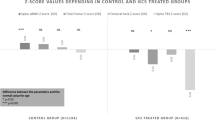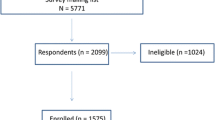Abstract
The mechanisms of male idiopathic osteoporosis are little known. We evaluated bone mineral loss by dual-energy X-ray absorptiometry and determined its cortical or trabecular nature in a cohort of men with idiopathic osteoporosis with fractures. Thirty-nine men (mean age 60 ± 13 years), with negative investigations for the cause of osteoporosis, were studied. All had fragility fractures: vertebral 51%, peripheral 25%, and both types 24%. Bone density was measured at the lumbar spine (L2-L4), total hip and whole body. The limb/axial skeleton (spine + hips) and hip/L2-L4 BMD ratios were calculated. Serum 25-hydroxy-vitamin D, PTH, bone alkaline phosphatase and CTX were measured. Bone mineral loss predominated at the lumbar spine (mean L2-L4 T-score −3 ± 0.93, mean total hip T-score −1.87 ± 0.75). Limb/axial skeleton and total hip/L2-L4 BMD were strongly correlated, but not hip and spine BMD. The ratio values were widely scattered, indicating markedly heterogeneous bone loss. Vitamin D, PTH, bone alkaline phosphatase and CTX levels did not differ between predominantly trabecular and cortical osteoporosis. Bone mineral density measurement in male idiopathic osteoporosis with fractures demonstrated that bone loss predominated in the spine and that it was very heterogeneous, principally affecting cortical or trabecular bone depending on the patient.

Similar content being viewed by others
References
Seeman E (1995) The dilemma of osteoporosis in men. Am J Med 98:76S–88S
Ebeling PR (2008) Clinical practice. Osteoporosis in men. N Engl J Med 358:1474–1482
Seeman E (2001) Unresolved issues in osteoporosis in men. Rev Endocr Metab Disord 2:45–64
Bilezikian JP (1999) Osteoporosis in men. J Clin Endocrinol Metab 84:3431–3434
Haney EM, Bliziotes MM (2008) Male osteoporosis: new insights in an understudied disease. Curr Opin Rheumatol 20:423–428
Boonen S, Kaufman JM, Goemare S et al (2001) The diagnosis and treatment of male osteoporosis: defining, assessing, and preventing skeletal fragility in men. Calcif Tissue Int 69:209–213
Grisso JA, Chiu GY, Maislin G et al (1991) Risk factors for hip fractures in men: a preliminary study. Bone 8:865–868
Seeman E, Melton LJ, O’Fallon WM et al (1983) Risk factors for osteoporosis in men. Am J Med 75:977–983
Seeman E, Bianchi G, Khosla S et al (2006) Bone fragility in men–where are we? Osteoporos Int 17:1577–1583
Pietschmann P, Kudlacek S, Grisar J et al (2001) Bone turnover markers and sex hormones in men with idiopathic osteoporosis. Eur J Clin Invest 31:444–451
Lormeau C, Soudan B, d’Herbomez M et al (2004) Sex-hormone-binding globulin, estradiol, and bone turnover markers in male osteoporosis. Bone 34:933–939
Kurland ES, Rosen CJ, Cosman F et al (1997) Insulin-like growth factor-1 in men with idiopathic osteoporosis. J Clin Endocrinol Metab 82:2799–2805
Cohen-Solal ME, Baudoin C, Omouri M et al (1998) Bone mass in middle-aged osteoporotic men and their relatives: familial effect. J Bone Miner Res 13:1909–1914
Marshall D, Johnell O, Wedel H (1996) Meta-analysis of how well measures of bone mineral density predict occurrence of osteoporotic fractures. BMJ 312:1254–1259
Schuit SC, Van Der Klift M, Weel AE (2004) Fracture incidence and association with bone mineral density in elderly men and women: the Rotterdam study. Bone 34:195–202
Legrand E, Chappard D, Pascaretti C et al (1999) Bone mineral density and vertebral fractures in men. Osteoporos Int 10:265–270
Mundy GR (1998) Remodelage osseux et mécanismes de la perte osseuse dans l’ostéoporose. In: Meunier PJ (ed) Ostéoporose: progrès dans le diagnostic et la prise en charge. Martin Dunitz Ltd, London, pp 17–36
Melton LJ, Looker AC, Shepherd JA et al (2005) Osteoporosis assessment by whole body region vs. site specific DXA. Osteoporos Int 16:1558–1564
Hangartner TN, Skugor M, Landoll JD et al (2000) Comparison of absorptiometry evaluations from total-body and local-regional skeletal scans. J Clin Densitom 3:215–225
Chavassieux P, Meunier PJ (2001) Histomorphometric approach of bone loss in men. Calcif Tissue Int 69:209–213
Delichatsios HK, Lane JM, Rivlin RS (1995) Bone histomorphometry in men with spinal osteoporosis. Calcif Tissue Int 56:359–363
Pernow Y, Hauge EM, Linder K et al (2009) Bone histomorphometry in male with idiopathic osteoporosis. Calcif Tissue Int 84:430–438
Uzzan B, Campos J, Cucherat M et al (1996) Effects on bone mass of long term treatment with thyroid hormones: a meta analysis. J Clin Endocrinol Metab 81:4278–4289
Christiansen P, Steiniche T, Brixen K et al (1997) Primary hyperparathyroidism: biochemical markers and bone mineral density at multiple skeletal sites in Danish patients. Bone 21:93–99
Chiodini I, Carnevale V, Torlontano M (1998) Alterations of bone turnover and bone mass at different skeletal sites due to pure glucocorticoid excess: study in eumenorrheic patients with Cushing’s syndrome. J Clin Endocrinol Metab 83:1863–1867
Lorentzon M, Mellström D, Haug E et al (2007) Smoking is associated with lower bone mineral density and reduced cortical thickness in young men. J Clin Endocrinol Metab 92:497–503
Conflict of interest
None.
Author information
Authors and Affiliations
Corresponding author
Rights and permissions
About this article
Cite this article
Laroche, M. Pattern of bone mineral density in idiopathic male osteoporosis. Rheumatol Int 32, 3093–3096 (2012). https://doi.org/10.1007/s00296-011-2076-7
Received:
Accepted:
Published:
Issue Date:
DOI: https://doi.org/10.1007/s00296-011-2076-7




